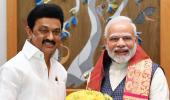If only the Congress could rebuild on its strengths and develop a modern enough ideology, we could again be moving towards a clearer two-party political landscape, asserts Shekhar Gupta.

The dramatic transformation in Maharashtra politics gives us an intriguing glimpse into the state of our national politics, where we currently stand, how we got here, and where we are headed next.
Some interesting questions follow. Does ideology still matter in politics? One might think it doesn't, if one looks at the rise of the Aam Aadmi Party.
However morally exalted, the promise of a corruption-free government and free this and free that do not make an ideology.
Not even when backed by framed portraits of Ambedkar and Bhagat Singh on the wall.
At the other end of the spectrum, the same conclusion can be reached by looking at the moves in Maharashtra: First, the Shiv Sena defected from the National Democratic Alliance to join ideological arch rivals, the Nationalist Congress Party and the Congress.
In the course of time, two of the three split and saw a majority of their MLAs defect back to the Bharatiya Janata Party.
Where does that even leave the idea of ideology and principle in politics? NCP leader and former United Progressive Alliance cabinet minister Praful Patel gave us an insight into this changed politics when questioned by journalists about justifying his switch to the BJP-led coalition.
When asked how he could justify this ideological switch, he said if the NCP had no problem aligning with the Shiv Sena, there should not be a problem in aligning with the BJP now.
I did see a comment from Sharad Pawar somewhere that it was okay to embrace the inclusive Hindutva of the Shiv Sena, but not the BJP's. Which, we know, and must dismiss as baloney.
The fact is that if one looks at the big picture with an open mind, ideology has become a stronger force than it has been in decades. Except, it works only on one side -- the BJP's.
On the other hand, too many leaders and their parties have thrived for these same decades in an ideologically permissive environment where principles and philosophical commitments have always been fungible with power.
The developments in Maharashtra politics over the past four years, however, are telling us that this era may now be over.
The Eknath Shinde Shiv Sena and the Ajit Pawar NCP may enjoy their short innings in power, but electorally and politically, they now represent political forces in terminal decline.
This could then spell the end of two mostly transactional political entities.
That the Shiv Sena and the NCP are almost entirely one-state parties does not matter as much as the fact that over the past 25 years, ruling coalitions in Delhi have almost always had one of the two as partners.
In the pre-Modi past, especially after the 2009 elections, many of us (this columnist included, so guilty by self-incrimination) were quick to hail the arrival of an ideology-free Indian politics.
The increasingly younger voter, we had concluded, had only one thought while hitting the button on the voting machine: What's in it for me? Narendra Modi kept that in mind in his 2014 campaign, but his larger appeal was of hard, Hindutva-based nationalism.

There were frequent references to Pakistan, and many indirect ones to Muslims, especially the questions over the justification for 'pink revolution' (electoral code for meat exports).
On the other hand, the Congress-led rivals sounded transactional with talk of the Mahatma Gandhi National Rural Employment Guarantee Act and other rights-based laws and welfarism.
By 2019, Mr Modi had moved on to even harder, post-Pulwama/ Balakot nationalism, while the Congress was fighting back with charges of corruption (Rafale, Chowkidar chor hai) and Nyay scheme handouts.
A clear ideological divide was still not created.
And if the Congress struggled, we can easily understand the predicament of the smaller, regional parties fighting the BJP.
The product differentiation they sought was either based on protection of Muslims, or handouts.
With the exception of some regional forces, the Dravida Munnetra Kazhagam (DMK ) and the Left in Kerala, no party other than the BJP fought in the name of its ideology. It made the fight that much easier for Mr Modi.
It's a point we make often because it is central to our post-1984 politics.
We take 1984 as the cut-off because that's when Rajiv Gandhi won his mandate of 415.
Since then, who rules India has been a function of one binary: Can one side use caste to divide what religion (Hinduism) united? Or will the other succeed in reuniting what caste divided?
For the first 25 years since the Congress lost power in 1984, the forces of caste won. Then came the Modi era.
It was in those 25 years the so-called secular politics became confused and lost its larger ideological moorings.
To oppose the BJP began to look increasingly as a utilitarian function of winning the Muslim vote rather than standing by a larger principle.
This is how the 'secular vote' became a synonym for the Muslim vote.
That led to local tussles also, as between the Samajwadi Party and the Bahujan Samaj Party in Uttar Pradesh, the Congress, Left and the Trinamool Congress in West Bengal, and also between the Congress and the newer Muslim forces such as Asaduddin Owaisi's AIMIM and Badruddin Ajmal's AIUDF in Assam.
In most states other than Maharashtra, the NCP also began putting up its own candidates -- as notably in the Gujarat elections of 2017, which once looked touch-and-go for the BJP.
Meanwhile, the BJP was making its product sharper, better-defined and unapologetically Hindu nationalist.
Its slogan of 'sabka saath, sabka vikaas' also underlined its raw, new confidence that while it knew the Muslims didn't vote for it, it will still not victimise them.
This created a one-sidedness to national politics, although the BJP failed to defeat local/regional powers in several of the states.
Barring Kerala and Tamil Nadu -- both of which aren't so relevant to the BJP -- in most other states, this challenge came from one leader or family parties.
These include Andhra, Telangana, West Bengal, Delhi, Bihar and Maharashtra. Many of those parties now need a rethink.
Families can be broken, nephews can ditch uncles, for example, loyalists can be either enticed or muscled out using the agencies, and they all have some version of the argument that Praful Patel offered to justify his move.

Delivering a lecture on the life of the late Lal Bahadur Shastri (titled Lal Bahadur Shastri -- The man who died too soon) at New Delhi's Nehru Memorial Library, editor and author T N Ninan raised an important point.
Thinking aloud on what would have happened if Shastri hadn't died too soon, he said one possibility was that the Congress wouldn't have split.
Or maybe, Indira Gandhi's time might have ended, paving the way for Y B Chavan as the successor instead.
It follows that if the party hadn't been split by Mrs Gandhi in 1969, it probably would not have taken such a sharp turn to the Left as she led it into.
She chose to do it to fight her own old guard.
In my view, this was expedient politics, not ideological conviction.
What better than ideas of the progressive, youthful Left to destroy the conservative ruddy daddies.
This she did with aplomb.

But in the process, the Congress was left with an ideology its rank and file, particularly the top leadership that remained with her, didn't fully buy into.
That's probably why the party has kept on splitting since then, almost at the rate of once every five years.
Most of these breakaway factions then became regional forces, from the NCP to the Sangmas of Meghalaya, Mamata's TMC to the YSRCP.
The BJP, on the other hand, kept its ideological and political cohesion.
A few leaders who broke away returned, such as B S Yediyurappa and Kalyan Singh.
And the odd one who didn't fade away: Shankersinh Vaghela.
This pretty much explains the state of national politics today. It is also the message from Maharashtra.
If only the Congress could rebuild on its strengths and develop a modern enough ideology, we could again be moving towards a clearer two-party, bipolar political landscape.
By special arrangement with The Print
Feature Presentation: Aslam Hunani/Rediff.com











